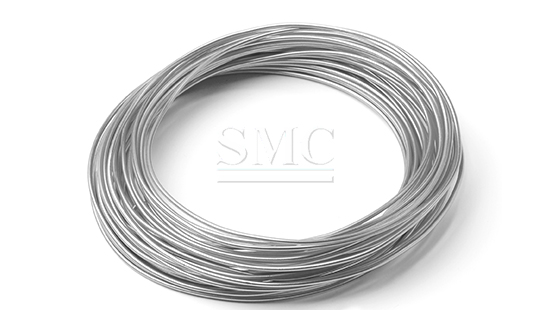The aluminum wire is a wire product obtained by drawing aluminum and aluminum alloy wire blanks as raw materials, including high-purity aluminum wire, ordinary aluminum wire and alloy aluminum wire. The high-purity aluminum wire has an aluminum content of 99.9% or more and is used in the electronics industry, vacuum coating, and aluminum-plated paper. Ordinary aluminum wire has an aluminum content of less than 99.9% and is used for the manufacture of wires, cables, motors, electrical appliances, and as rivets and welding materials. Aluminum alloy wires are used in the electronics and textile sectors as well as in wires, cables, rivets, solders, etc.
Aluminum is a chemical element. Its chemical symbol is Al, and its atomic number is 13. The content of aluminum in the earth’s crust is second only to oxygen and silicon, ranking third, and is the most abundant metal element in the earth’s crust. Among the metal varieties, second only to steel, it is the second largest category of metal. By the end of the 19th century, aluminum had emerged as a competitive metal in engineering applications and was popular. The development of three important industries of aviation, construction and automobile requires that the material properties have the unique properties of aluminum and its alloys, which is greatly beneficial to the production and application of this new metal aluminum. The application of aluminum is extremely extensive.

The conductivity of aluminum is second only to silver and copper. Although its conductivity is only 2/3 of that of copper, its density is only 1/3 of that of copper. Therefore, the same amount of electricity is delivered. The quality of aluminum wire is only half of that of copper wire. The oxide film on the aluminum surface is not only resistant to corrosion but also has a certain degree of insulation, so aluminum has a wide range of uses in the electrical appliance manufacturing industry, the wire and cable industry, and the radio industry.
The 3003 series aluminum wire is a commonly used product in the aluminum-manganese alloy series. Thanks to the manganese alloy element, this product has excellent rust-proof properties and is also known as rust-proof aluminum. The strength is about 10% higher than that of the 1100 series aluminum wire, and the formability, the weldability, and the corrosion resistance are good. Used for processing parts and parts that require good formability and high corrosion resistance, such as kitchen utensils, food and chemical processing and storage devices, tanks and tanks for transporting liquid products, and various pressures for processing thin sheets. Containers and pipes, general objects, heat sinks, cosmetic boards, photocopier drums, marine materials, etc.
Aluminum 7075 is a cold-treated forging alloy with high strength and far better than mild steel. 7075 aluminum alloy is one of the most powerful alloys in commercial use. Common corrosion resistance, good mechanical properties and anode reaction. The fine grain size makes the deep drilling performance better, the tool wear resistance is enhanced, and the thread rolling is more different from the weight.
Guest contributors are welcome at the Alloy Wiki.It is a weekly wiki and guide on alloy information and processing technology, while also about the vast array of opportunities that are present in manufacturing. Our team of writers consists of a Machining Material Supplier / Machinist / Tool and Die Maker, a Biomedical Engineer / Product Development Engineer, a Job Development Coordinator / Adjunct Professor, and a President and CEO of a manufacturing facility.
Link to this article:Characteristics And Uses of Aluminum Wire
Reprint Statement: If there are no special instructions, all articles on this site are original. Please indicate the source for reprinting:Alloy Wiki,thanks!^^


